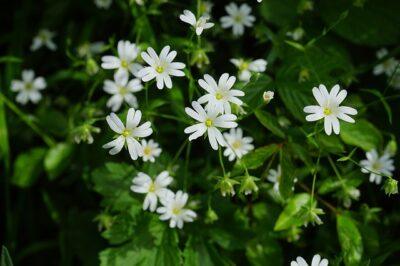What the heck is chickweed and why would I want it in my salad? If you’re like many gardeners, you yank this common weed out of your carefully tended vegetable garden and toss it into your compost bin. Using chickweed as compost isn’t a terrible idea, but you’re missing out on a versatile, flavorful plant. Better yet, you don’t have to plant it, and it’s completely free.
Chickweed is truly worthy of superfood status, rich in vitamins B, C and D, and minerals such as calcium, copper, manganese, potassium, phosphorus and iron. The plant provides anti-inflammatory properties and is believed to be a blood purifier. It has been used through the ages for its many medicinal qualities.
Chances are good that you have easy access to this tasty weed; it grows in nearly every climate across North America.
Dangerous Lookalikes
Before you decide to harvest chickweed for edible purposes, be sure you know exactly what you’re harvesting, because spurge and scarlet pimpernel are chickweed lookalikes. Both are poison and the latter can be deadly, so do your homework. (Although the Internet has a lot of very good information, it’s a good idea to confirm identification in person with two or three experts before eating any wild plant.)
Identifying Chickweed
Chickweed (Stellaria media) tends to grow in thick, intertwined mats, usually no more than four inches in height. Its most important distinguishing characteristic is a single, thin line of white hair that runs up the stems.
Discover How To Make Powerful Herbal Medicines, Right in Your Kitchen!
Chickweed produces tiny, tear-shaped leaves and dainty, white, star-shaped flowers. The flowers look like they have 10 petals, but if you look closer you can see they actually consist of five, deeply indented petals. This is an important identifying feature.
The Harvest
Look for chickweed in spring and cool weather, as this isn’t a heat- or sun-loving plant. You’ll find it growing in woods, meadows, roadsides, lawns or shady garden spots – usually places that have been disturbed. Chickweed may grow in full sunlight, but it flowers and goes to seed quickly. When conditions are just right and temperatures aren’t too warm, you can harvest the plant for up to six weeks.
To harvest chickweed, grab a handful and pull the bunch straight up. Locate the tips of the plants and cut the upper six inches or so with scissors or clippers. Leave the base and lower stems, which tend to be a little on the tough, stringy side. Pick out grass and other less palatable plant matter, and you’re good to go.
Using Chickweed
Have fun and use your imagination, because the sky is the limit when it comes to using chickweed in the kitchen.
The plant is tastiest when used fresh. You may be tempted to dry it like an herb, but it doesn’t last long and loses its nutritional qualities quickly. Instead, store chickweed in the refrigerator as you would spinach or lettuce. If you harvested more than you can possibly use, freeze it and add it to soup stock or other hot dishes.
Salad is the obvious choice for using any type of green, and it’s a good way for beginners to experiment with this tasty wild plant. Snip chickweed into small pieces and add it to a green salad along with grated carrots or beets. Other tasty and nutritious additives include sunflower seeds, nuts, parsley, chives or other wild greens like watercress.
Stir chopped chickweed into omelets or scrambled eggs. Chickweed pairs just fine with mushrooms, onions or other veggies.
Steam chickweed much like spinach or other greens. Make it quick, as overcooking causes loss of valuable nutrients. You can also add chickweed to your favorite stir fry.
Create a chickweed sandwich. For example, pile a handful of chopped chickweed on a slice of tasty bread and sprinkle it with a little sea salt or drizzle lightly with olive oil, balsamic vinegar or fresh lemon juice. You can always add chickweed to a tuna sandwich, or pile on bacon, tomato or avocado.
Blend chickweed into a smoothie. If you want a super-nutritional treat, combine chickweed with other wild plants like nettles, watercress, lamb’s quarters or dandelion leaves. If you aren’t wild about the slightly earthy flavor, try adding fruit. Any type is great, but citrus fruits like pineapple and orange are especially delicious.
Have you eaten chickweed? What advice would you add on picking and eating it? Share your tips in the section below:
Harness The Power Of Nature’s Most Remarkable Healer: Vinegar
 Off The Grid News Better Ideas For Off The Grid Living
Off The Grid News Better Ideas For Off The Grid Living






